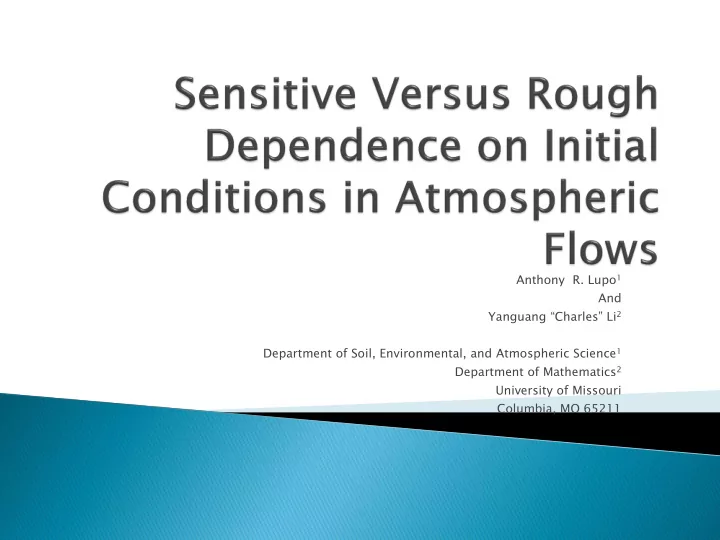

Anthony R. Lupo 1 And Yanguang “Charles” Li 2 Department of Soil, Environmental, and Atmospheric Science 1 Department of Mathematics 2 University of Missouri Columbia, MO 65211
Sensitive Dependence on Initial Conditions (SDOIC) is the idea that similar initial states can evolve very differently over time (slowly). The concept plagues weather forecasters, and techniques have been developed (e.g., Ensemble modeling) in order to mitigate the issue.
Ensemble products:
Occasionally, atmospheric phenomena may develop at an exponential rate, and initially similar states diverge rapidly with time. Thus, we introduce the concept of Rough Dependence on Initial Conditions (RDOIC) to explain this behavior and define it in terms of quantities we can measure.
Reynolds number – ratio of inertial to viscous forces Large Reynolds number Atmosphere is three dimensional and dominated by inertial forces. Very large atmosphere dominated by ‘violent’ turbulence. (Explosive development?)
SDOIC in a three dimensional system, at least one Lyapunov Exponent must be positive. It is a measure of ‘stability’ (rate of separation of trajectories) – characteristic exponent in the solution of a DIFFEQ:
In the atmosphere: Dymnikov (1992) showed that in a barotropic atmosphere, the positive LE can be expressed as: Lupo et al. (2007) (then Hussain et al. 2010, Jensen and Lupo, 2013) call this quantity “Integrated Regional Enstropy ” (IRE)
Li (2014) – estimates the temporal growth of modes in the Navier-Stokes equations resulting in: This implies the exponential growth (as a function of ‘Re’ and time can be larger than that implied by the LE (if equal – SDOIC).
If IRE is the LE – then using the previous equation produces the following inequality: Thus, if IRE is smaller than the LE implied by the Re, the we have RDOIC not SDOIC. This can be an issue in rapid development.
23 Jan, 2014 – 16 Feb, 2014
Need to estimate RE: And constants from Li (2014):
RDOIC – is going to be evident if the time- scale for development and evolution is smaller than that implied by the Reynolds number. In the case of this blocking event, the time- scale for growth was ‘typical’ of the synoptic and planetary-scale (about three days)! Predictable….
20-24 October – Cat 5 – 200 mph sustained winds! Deepened: 124 hPa in 36 hr (1004 to 880 hPa)
Deepened at ten times (!) the rate of the definition for mid-latitude explosive cyclogenesis (24 hPa / 24 hr * sin (lat)/sin (60))
RDOIC – is going to be evident if the time- scale for development and evolution is smaller than that implied by the Reynolds number. In the case of Patricia, the time-scale for growth was characteristic of that of the Meso- g scale (convection)! RDOIC probably describes this case.
SDOIC is a problem for weather forecasting, and the uncertainty that it implies has been accommodated using various ensemble products. We develop an expression to quantify RDOIC as a function of variables that are meteorologically relevant.
In the case of blocking from 23 Jan – 16 Feb 2014 – SDOIC characterized the time scale for development of this event. This is probably true for most blocking events – predictable. In the case of Hurricane Patricia – developed at a ‘hyper’ explosive rate. Thus, RDOIC likely characterizes this event (still need to determine), and the probability that models could have captured it are small.
Questions? Comments? Criticisms? Email: lupoa@missouri.edu
120 H
Recommend
More recommend